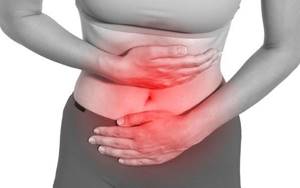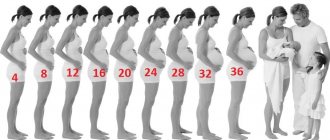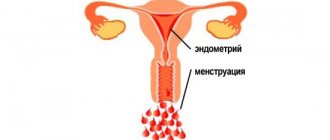What does it mean to tear or rip your stomach?
When they say that the abdomen is torn, they mean excessive tension in the muscle fibers. This condition occurs when a lot of pressure is applied to the muscles of the anterior abdominal wall. In this case, intra-abdominal pressure increases significantly. You can also hear the expression, your stomach was ripped off.
When the stomach is torn, we are talking about a significant weakening of the abdominal muscles. This condition is accompanied by complications such as prolapse of internal organs, umbilical and inguinal hernia. In this case, the muscle tissue is exposed to great force and pressure quite often.
If the expectant mother fell...
Falls and any mechanical injuries during pregnancy should be avoided in every possible way - this is a fact. However, this task is sometimes extremely difficult to accomplish.
After all, a pregnant woman is not exempt from many responsibilities that require her to move around the city, be in crowded places, in transport, etc. We are talking, in particular, about work that must be attended during the first two trimesters of pregnancy, about going to the antenatal clinic , about various household affairs and concerns.
That is why it is so difficult to meet a woman who would be able to completely avoid falls, collisions, and blows during pregnancy.
The woman is afraid, of course, not so much of the possibility of injury (which in itself is quite unpleasant), but of the possibility of harming the child. And therefore it is necessary to consider how dangerous a fall is during pregnancy and how it can harm the unborn baby.
Natural child protection
Nature itself provides that the baby in the mother’s tummy is reliably protected. The amniotic sac and amniotic fluid protect the baby from any mechanical injury. After all, the shells of this bubble are dense connective tissue, and the liquid can reliably absorb the force of a possible impact.
In addition, the walls of the abdominal cavity and the elastic muscles of the uterus play a significant role in protecting the unborn child from mechanical damage. And if we are talking about the early stages of pregnancy , then the fetus is also covered by the mother’s pelvic bones.
Note that the period when the fetus is protected by the pelvic bones is considered one of the safest from the point of view of possible mechanical injuries. It continues until the fifth month of pregnancy - until the uterus enlarges so much that it extends beyond the area covered by the pelvic bones.
Thus, the baby in the belly of the expectant mother has its own natural protection. However, this does not mean that a fall or injury cannot harm him. Very often, falls or strong impacts cause premature labor or miscarriage.
And, in addition, there is a danger that the consequences of a fall by a pregnant woman will appear on her child after some time. Although this only applies to severe blows to the stomach, the consequences of car accidents, etc.
What to do if you fall?
As practice shows, many expectant mothers wonder what to do if they fall. Here are some simple recommendations that can help you:
- If you fall or hit your stomach , stop for a while and listen to your own feelings.
- Sit or even lie on the ground for a few minutes. You should not get to your feet immediately - you may feel dizzy or feel worse.
- Try to pull yourself together and not panic. There is absolutely no need for unnecessary worries in such a situation.
- If after a fall you feel dizziness, sharp pain anywhere, if your water breaks or bleeding appears, call an ambulance immediately.
Be sure to tell your doctor
Even if you don’t notice any tangible consequences of the fall, if you don’t have any pain, and the baby in your stomach moves in the same way as before, you will still need to visit a doctor. This will help you finally calm down and dispel all worries, because the doctor can listen to the baby’s heart, prescribe an ultrasound examination and other necessary procedures.
Causes of the pathological condition
There are quite a few reasons for the occurrence of abdominal tearing and breakdown. All of them are associated with an increase in intra-abdominal pressure and a sharp change in the position of the muscles of the anterior abdominal wall.
The most common causes of this pathological condition are:
- Engaging in strenuous sports;
- Frequent lifting of heavy objects (people of the following professions are at risk: loader, miner, track fitter and others);
- A sharp turn and movement of the body when playing sports or during a sports game;
- Conducting a workout without proper preparation of muscle tissue (lack of warm-up);
- Intense paroxysmal cough. With coughing shocks, intra-abdominal pressure increases significantly. Cough often causes abdominal pain in children. This is due to the weakness of their abs;
- Sudden change in body weight. In this case, muscle tissue does not have time to adapt to changing conditions;
- Recent surgical treatment in the abdominal wall (appendicitis, peritonitis, etc.);
- Chronic constipation;
- Injuries in the abdominal area , which can occur under various circumstances. In this case, inflammation and damage to muscle fibers may occur.
Spool displacement (navel)
What is this spool in the stomach? The spool (navel) is a formation in the center of the umbilical fossa, which can be easily felt during palpation. It is formed from the umbilical cord, which is cut after the birth of the child.
Under certain conditions, the spool may move in different directions.
The causes of navel displacement include:
- Blunt abdominal trauma (eg, blow);
- Lifting heavy objects with poor technique;
- Surgical treatment of abdominal organs;
- Nervous tension and frequent stress;
- Childbirth.
This is useful to know!
Nadezhda belly
Abdominal swelling - this concept characterizes the symptoms of prolapse of the internal organs of the abdominal cavity. This condition can occur in both men and women.
The reasons for its occurrence can be divided into 2 groups:
- Difficult childbirth for women. At the same time, the muscular frame (abs, pelvic floor muscles) weakens, which leads to a gradual prolapse of the internal organs;
- Heavy physical work involving heavy lifting.
This pathology is the cause of many diseases that can be eliminated by eliminating the root cause.
Treatment: what to do about the disease?
A cushion is placed under the patient's lower back
Before starting treatment, it is necessary to properly assist the patient before the doctor arrives.
- If, after lifting weights, a person begins to experience severe pain in the abdominal area, the first step is to securely fix his body in one position.
- The patient is placed on a flat and hard surface, and a cushion of hard material is placed under the lower back.
- Needs a tummy tuck. To do this, a strip of 20-30 cm of fabric is wrapped around the abdomen. The first turn should be near the groin, the second through the navel, and the third through the diaphragm. The bandage must be tight, but in no case too tight.
Particular caution must be exercised with women, since a similar clinical picture can also develop with diseases of the genitourinary system. The patient should not get up right away; care must be taken to rise gradually from the side and not from the back.
Ibuprofen for pain relief
After hospitalization, the doctor will visually examine the patient, conduct the necessary studies and develop a treatment regimen, taking into account the condition and individual characteristics of the body. As a rule, treatment is prescribed as follows:
- Complete physical rest, stress should be kept to an absolute minimum.
- Regular use of painkillers, for example, Ketorol, Ibuprofen and their analogues.
- During the first day, cold is applied to the abdomen to relieve swelling. The frequency of the procedure is 15-20 minutes, 6 times a day.
- The use of local painkillers, for example, Indomethacin, Nise, Ketonal, Fastum-gel.
- Reliable fixation of the outer wall of the abdominal cavity using a bandage; its inner surface should have a soft surface.
- On days 2-3 and later, you can begin to apply dry heat to the painful area. You can use an infrared or blue lamp, heated salt or sand. Apply 2-3 times during the day for 15 minutes.
The load must be increased gradually
The recovery period also plays an important role. It takes about two weeks for complete regeneration of muscle fibers. Any physical activity should be excluded, only therapeutic exercises are possible. Exercise therapy will prevent the formation of contracture of the abdominal muscles.
The essence of the exercises is to tilt the torso forward and backward, to the sides. The load is increased gradually; there should be no pain during exercise. Initially, the duration of classes is no more than 15-20 minutes. From the second week of the rehabilitation period, it is necessary to do exercises to stretch the muscle fibers, for example, in the starting position, lying on your stomach, the torso is extended backwards, resting your hands on the floor.
Good results can be achieved by performing light warming massages on the sides and front of the abdomen. To enhance the effect, it is recommended to use warming ointments, for example, Capsicum, Dolobene, Myoton.
After examination by a doctor and exclusion of a more serious pathology when the abdominal muscles are strained, the following treatment is prescribed:
- physical peace;
- painkillers (ibuprofen, ketorol and their analogues);
- cold on the stomach during the first day, apply a heating pad with cold water for 15-20 minutes up to 6 times a day;
- local painkillers (fastum-gel, ketonal, nise, indomethacin);
- fixation with a special bandage with a soft inner surface;
- dry heat on the painful area - for 2-3 days, you can apply a warm heating pad, heated sand or salt, and also use a blue or infrared lamp for 15 minutes 2-3 times a day.
Correct treatment gives a quick effect, after a few days the pain subsides, and movement becomes possible.
- Exposure to cold
- Warmer
- Stretching
If an umbilical hernia is diagnosed, its reduction is not enough, since there is a high probability of complications. In this case, surgery is recommended; in this case, consultation with a nutritionist and gastroenterologist will be required.
Before surgery, an examination is carried out; in the absence of contraindications (acute forms of disease, pregnancy, heart failure), the doctor prescribes surgery.
Types of operations:
- tension hernioplasty;
- plastic surgery with mesh implants.
During these operations, local or general anesthesia is administered.
You can often hear from a person that he has torn or torn his stomach. What does this mean? It can be assumed that this is a pathological condition of the abdominal wall. However, what can it be connected with and how does it manifest itself? Is it possible to tear your stomach while lifting weights and what to do? These questions should be examined in more detail.
What does it mean to tear or rip your stomach?
When they say that the abdomen is torn, they mean excessive tension in the muscle fibers. This condition occurs when a lot of pressure is applied to the muscles of the anterior abdominal wall. In this case, intra-abdominal pressure increases significantly. You can also hear the expression, your stomach was ripped off.
Torn and torn are somewhat different concepts.
When the stomach is torn, we are talking about a significant weakening of the abdominal muscles. This condition is accompanied by complications such as prolapse of internal organs, umbilical and inguinal hernia. In this case, the muscle tissue is exposed to great force and pressure quite often.
Causes of the pathological condition
There are quite a few reasons for the occurrence of abdominal tearing and breakdown. All of them are associated with an increase in intra-abdominal pressure and a sharp change in the position of the muscles of the anterior abdominal wall.
The most common causes of this pathological condition are:
- Engaging in strenuous sports;
- Frequent lifting of heavy objects (people of the following professions are at risk: loader, miner, track fitter and others);
- A sharp turn and movement of the body when playing sports or during a sports game;
- Conducting a workout without proper preparation of muscle tissue (lack of warm-up);
- Intense paroxysmal cough. With coughing shocks, intra-abdominal pressure increases significantly. Cough often causes abdominal pain in children. This is due to the weakness of their abs;
- Sudden change in body weight. In this case, muscle tissue does not have time to adapt to changing conditions;
- Recent surgical treatment in the abdominal wall (appendicitis, peritonitis, etc.);
- Chronic constipation;
- Injuries in the abdominal area, which can occur under various circumstances. In this case, inflammation and damage to muscle fibers may occur.
Spool displacement (navel)
What is this spool in the stomach? The spool (navel) is a formation in the center of the umbilical fossa, which can be easily felt during palpation. It is formed from the umbilical cord, which is cut after the birth of the child.
Under certain conditions, the spool may move in different directions.
Causes of navel displacement include:
- Blunt abdominal trauma (eg, blow);
- Lifting heavy objects with poor technique;
- Surgical treatment of abdominal organs;
- Nervous tension and frequent stress;
- Childbirth.
This is useful to know!
Abdominal swelling - this concept characterizes the symptoms of prolapse of the internal organs of the abdominal cavity. This condition can occur in both men and women.
The reasons for its occurrence can be divided into 2 groups:
- Difficult childbirth for women. At the same time, the muscular frame (abs, pelvic floor muscles) weakens, which leads to a gradual prolapse of the internal organs;
- Heavy physical work involving heavy lifting.
This pathology is the cause of many diseases that can be eliminated by eliminating the root cause.
Signs of a torn and torn abdomen
How can you tell if your stomach is torn? If a person has torn or torn his stomach, then he will develop corresponding pathological signs. Knowing them, you can suspect this pathology and begin treatment.
Symptoms of a tear and torn abdomen in women and men:
- Pain in the lower abdomen. The nature of the pain can be different: shingles, paroxysmal, shooting. In some cases, the pain is so intense and prolonged that a person cannot take a deep breath and straighten up;
- Hematomas on the abdominal wall;
- Bloating. When the spool is displaced, increased gas formation and rumbling in the navel area are noted;
- Press tension;
- Displacement of the navel provokes the development of various pathologies of the abdominal organs with corresponding symptoms: cholecystitis, gastritis and gastric ulcers, cholelithiasis, pancreatitis, diabetes mellitus;
- Swelling, which is noted in the lower abdomen;
- Motor activity is reduced due to pain.
There are also a number of additional signs that do not always appear:
- General hyperthermia (increased body temperature). It is observed in severe cases when acute inflammation of organs occurs against the background of prolapse;
- The presence of blood in the stool is observed when the intestines are involved in the pathological process;
- Darkening of the umbilical ring.
It should also be noted that there are specific symptoms in men and women.
Among women
In representatives of the fair half of humanity, a tear in the abdomen is manifested by pathologies of the internal genital organs.
Symptoms that a woman has torn her stomach from the internal genital organs:
- Prolapse of the uterus. Often occurs when the spool is displaced towards the uterus. In this case, urinary incontinence is observed;
- Infertility develops when the nutrition of the uterus and the function of the appendages is disrupted, and its downward displacement is observed;
- Miscarriages and miscarriage are associated with insufficient nutrition of the uterus, when the fetus cannot securely attach to the inner lining (endometrium).
In men
The development of an inguinal hernia may be a symptom that a man has torn or torn his stomach. In this case, a hernial protrusion in the inguinal fold is observed.
The prolapse of internal organs can provoke the development of problems in the male genital area:
- Prostatitis is inflammation of the prostate gland. This causes pain in the groin and pubic area, as well as when urinating. Frequent and difficult urination;
- Erectile dysfunction (impotence).
Hernia reduction
Signs of a torn and torn abdomen
How can you tell if your stomach is torn? If a person has torn or torn his stomach, then he will develop corresponding pathological signs. Knowing them, you can suspect this pathology and begin treatment.
Symptoms of a tear and
torn abdomen in women and men :
- Pain in the lower abdomen . The nature of the pain can be different: shingles, paroxysmal, shooting. In some cases, the pain is so intense and prolonged that a person cannot take a deep breath and straighten up;
- Hematomas on the abdominal wall;
- Bloating. When the spool is displaced, increased gas formation and rumbling in the navel area are noted;
- Press tension;
- Displacement of the navel provokes the development of various pathologies of the abdominal organs with corresponding symptoms: cholecystitis, gastritis and gastric ulcers, cholelithiasis, pancreatitis, diabetes mellitus;
- Swelling, which is noted in the lower abdomen;
- Motor activity is reduced due to pain.
There are also a number of additional signs that do not always appear:
- General hyperthermia (increased body temperature). It is observed in severe cases when acute inflammation of organs occurs against the background of prolapse;
- The presence of blood in the stool is observed when the intestines are involved in the pathological process;
- Darkening of the umbilical ring.
It should also be noted that there are specific symptoms in men and women.
Among women
In representatives of the fair half of humanity, a tear in the abdomen is manifested by pathologies of the internal genital organs.
Symptoms
that a woman has torn her stomach from the internal genital organs:
- Prolapse of the uterus. Often occurs when the spool is displaced towards the uterus. In this case, urinary incontinence is observed;
- Infertility develops when the nutrition of the uterus and the function of the appendages is disrupted, and its downward displacement is observed;
- Miscarriages and miscarriage are associated with insufficient nutrition of the uterus, when the fetus cannot securely attach to the inner lining (endometrium).
In men
The development of an inguinal hernia may be a symptom that a man has torn or torn his stomach. In this case, a hernial protrusion in the inguinal fold is observed.
Prolapse of internal organs can provoke the development of problems in the male genital area:
- Prostatitis is inflammation of the prostate gland. This causes pain in the groin and pubic area, as well as when urinating. Frequent and difficult urination;
- Erectile dysfunction (impotence).
The child has
The younger the child, the greater the likelihood of developing abdominal tears. This is due to the physiological characteristics of muscle tissue in children.
Symptoms if a child has torn his stomach are as follows:
- Constipation with accumulation of gases in the intestines;
- Decreased or complete absence of appetite;
- The child becomes lethargic and capricious;
- Sleep disturbance;
- Stomach ache;
- Development of an umbilical or inguinal hernia. When it is pinched, acute pain occurs and areas of soft tissue necrosis occur.
Symptoms and signs
The main factors contributing to the occurrence of muscle tears are:
- Sharp fluctuations in body weight, worsening the condition of the abdominal muscles;
- Damage and trauma to the abdomen that led to fiber ruptures;
- Frequent constipation;
- Removal of appendicitis or other surgical intervention.
Women are more likely to experience abdominal muscle tears. In this case, the symptoms of injury are:
- Shooting, encircling spasmodic pain in the lumbar region and lower abdomen;
- Swelling may occur in the abdominal area;
- Due to the displacement of the spool below the navel, pain is often accompanied by bloating or rumbling in the abdomen, as well as diarrhea;
- There is also a change in the color of the umbilical ring;
- Sometimes the damage is accompanied by stabbing pain in the side, which can radiate to the groin on the right and left;
- With a significant degree of damage, the pain is so severe that the person cannot straighten up and breathe deeply. Palpation is also painful.
Additional symptoms tend to occur quite rarely. These include the presence of blood in the stool, a sharp increase in temperature, accompanied by a change in skin tone in favor of a darker one. You can independently diagnose a tear by visually examining the abdomen on an empty stomach.
To do this, press the navel area with your thumb, and if a pulsation is felt along the upper edge, then this is a sign of a tear. The absence of pulsation may be evidence of a hernia.

First aid to the victim
What to do if a person tore his stomach? It is necessary to provide him with assistance, after which he must be taken to the hospital.
First aid is not complicated and includes several points:
- Create peace for the victim. It is necessary to lay the person on his back on a flat, hard surface. To relax the muscles, you need to bend your legs at the knees and hip joints;
- Apply a bandage using a wide cloth (not less than 25 and not more than 30 centimeters wide). You need to start bandaging from the groin towards the diaphragm. The bandage should not put too much pressure on the abdominal cavity, so as not to aggravate the condition;
- Apply cold to the sore spot.
The patient must be taken to the surgical department; for this, an ambulance should be called.
Treatment of pathology
Treatment depends on the severity of the pathology and the type of injury. If a person exhibits symptoms that he has torn his stomach, then consultation with a surgeon is necessary. If the muscle damage is minor, then treatment is carried out on an outpatient basis (at home).
If a hernia occurs, it is strangulated, or muscle tissue ruptures, surgical treatment is indicated.
Conservative treatment of abdominal tear:
- Using a bandage to fix muscles and reduce pain, it is also a preventive measure for prolapse of internal organs. The bandage must be put on while lying down on a flat surface;
- The use of painkillers for severe pain;
- Anti-inflammatory therapy;
- Compliance with the protective regime : refrain from lifting heavy objects, do not make sudden movements or bends, smooth, gradual rise from a horizontal position;
- The food is correct and complete.
Similar article - Vomiting of bile with pancreatitis
Surgical treatment :
- Restoring the integrity of muscle tissue;
- Plastic surgery for hernial protrusion.
In the postoperative period, it is necessary to wear a bandage, avoid increased intra-abdominal pressure (strong laughter, carrying heavy objects, constipation), and follow the recommendations given by the attending surgeon.
Spool (navel) in the abdomen
If the spool is displaced, it must be replaced. However, this is not so easy to do. This procedure must be performed by a trained person.
You can put the spool in place using a massage or a jar:
- Treatment with massage. At the same time, the skin of the abdomen and the massage therapist’s hands are soaped. Circular movements are performed throughout the abdomen. At first the circles are large (under the ribs and above the pubis), but gradually the circle becomes smaller and forms around the navel. This method is painless;
- Treatment with a cup. The abdomen is lubricated with vegetable oil and with massage movements they try to put the navel in place. After that, a circle of potatoes is placed on the navel, wrapped in a cloth, the ends of which stick out (they must be moistened with alcohol). The ends are set on fire and a jar is placed on the navel. Keep the jar for 10 minutes, after which it is carefully removed. Check that the spool is in the correct place.
Belly edit
Editing is carried out with the patient lying on his back in a relaxed state.
The masseur lubricates his hands with cream to improve gliding. Reduction is carried out using gentle massage movements. You cannot press or pull down too hard, as this can lead to strangulation of the hernia, as well as prolapse of organs.
An air hernia (air in the hernial sac) is reduced using a spiral motion.
Traditional methods
What to do if your stomach is torn or torn? You can use folk recipes. But this can only be done with slight damage to the muscle fibers.
Traditional methods of treatment:
- Warming up with clay. It is necessary to make a cake from red clay, which is heated, wrapped in cloth and applied to the sore spot until it cools and dries;
- In the first days, cooled cabbage leaves are applied to the affected area;
- Wrap the salt in a cloth. Moisten the resulting bag and apply it to the sore spot.
Victor Systemov - expert of the 1Travmpunkt site
Lifting weights can often lead to unpleasant consequences, one of them is
a torn abdomen, the symptoms of the pathology are similar to an umbilical hernia. This term also applies to abdominal muscle strain, which is much less common. A stomach ache most often occurs as a result of lifting very heavy objects.
I tore my stomach - symptoms of a torn spool in women and men, what to do and how to treat
You can often hear from a person that he has torn or torn his stomach. What does this mean? It can be assumed that this is a pathological condition of the abdominal wall. However, what can it be connected with and how does it manifest itself? Is it possible to tear your stomach while lifting weights and what to do? These questions should be examined in more detail.
What does it mean to tear or rip your stomach?
When they say that the abdomen is torn, they mean excessive tension in the muscle fibers. This condition occurs when a lot of pressure is applied to the muscles of the anterior abdominal wall. In this case, intra-abdominal pressure increases significantly. You can also hear the expression, your stomach was ripped off. Torn and torn are somewhat different concepts.
When the stomach is torn, we are talking about a significant weakening of the abdominal muscles. This condition is accompanied by complications such as prolapse of internal organs, umbilical and inguinal hernia. In this case, the muscle tissue is exposed to great force and pressure quite often.
Causes of the pathological condition
There are quite a few reasons for the occurrence of abdominal tearing and breakdown. All of them are associated with an increase in intra-abdominal pressure and a sharp change in the position of the muscles of the anterior abdominal wall.
The most common causes of this pathological condition are:
- Engaging in strenuous sports;
- Frequent lifting of heavy objects (people of the following professions are at risk: loader, miner, track fitter and others);
- A sharp turn and movement of the body when playing sports or during a sports game;
- Conducting a workout without proper preparation of muscle tissue (lack of warm-up);
- Intense paroxysmal cough. With coughing shocks, intra-abdominal pressure increases significantly. Cough often causes abdominal pain in children. This is due to the weakness of their abs;
- Sudden change in body weight. In this case, muscle tissue does not have time to adapt to changing conditions;
- Recent surgical treatment in the abdominal wall (appendicitis, peritonitis, etc.);
- Chronic constipation;
- Injuries in the abdominal area , which can occur under various circumstances. In this case, inflammation and damage to muscle fibers may occur.
Spool displacement (navel)
What is this spool in the stomach? The spool (navel) is a formation in the center of the umbilical fossa, which can be easily felt during palpation. It is formed from the umbilical cord, which is cut after the birth of the child.
Under certain conditions, the spool may move in different directions.
The causes of navel displacement include:
- Blunt abdominal trauma (eg, blow);
- Lifting heavy objects with poor technique;
- Surgical treatment of abdominal organs;
- Nervous tension and frequent stress;
- Childbirth.
Nadezhda belly
Abdominal swelling - this concept characterizes the symptoms of prolapse of the internal organs of the abdominal cavity. This condition can occur in both men and women.
The reasons for its occurrence can be divided into 2 groups:
- Difficult childbirth for women. At the same time, the muscular frame (abs, pelvic floor muscles) weakens, which leads to a gradual prolapse of the internal organs;
- Heavy physical work involving heavy lifting.
This pathology is the cause of many diseases that can be eliminated by eliminating the root cause.
Signs of a torn and torn abdomen
How can you tell if your stomach is torn? If a person has torn or torn his stomach, then he will develop corresponding pathological signs. Knowing them, you can suspect this pathology and begin treatment.
Symptoms of a tear and torn abdomen in women and men :
- Pain in the lower abdomen . The nature of the pain can be different: shingles, paroxysmal, shooting. In some cases, the pain is so intense and prolonged that a person cannot take a deep breath and straighten up;
- Hematomas on the abdominal wall;
- Bloating. When the spool is displaced, increased gas formation and rumbling in the navel area are noted;
- Press tension;
- Displacement of the navel provokes the development of various pathologies of the abdominal organs with corresponding symptoms: cholecystitis, gastritis and gastric ulcers, cholelithiasis, pancreatitis, diabetes mellitus;
- Swelling, which is noted in the lower abdomen;
- Motor activity is reduced due to pain.
There are also a number of additional signs that do not always appear:
- General hyperthermia (increased body temperature). It is observed in severe cases when acute inflammation of organs occurs against the background of prolapse;
- The presence of blood in the stool is observed when the intestines are involved in the pathological process;
- Darkening of the umbilical ring.
It should also be noted that there are specific symptoms in men and women.
Among women
In representatives of the fair half of humanity, a tear in the abdomen is manifested by pathologies of the internal genital organs.
symptoms that a woman has torn her stomach from the internal genital organs:
- uterine prolapse. often occurs when the spool is displaced towards the uterus. in this case, urinary incontinence is observed;
- infertility develops when the nutrition of the uterus and the function of the appendages is disrupted, and its downward displacement is observed;
- miscarriages and miscarriages are associated with insufficient nutrition of the uterus, when the fetus cannot securely attach to the inner lining (endometrium).
in men
the development of an inguinal hernia may be a symptom that a man has torn or torn his stomach. in this case, a hernial protrusion in the inguinal fold is observed.
prolapse of internal organs can provoke the development of problems in the male genital area:
- prostatitis – inflammation of the prostate gland. this causes pain in the groin and pubic area, as well as when urinating. frequent and difficult urination;
- Erectile dysfunction (impotence).
The child has
The younger the child, the greater the likelihood of developing abdominal tears. this is due to the physiological characteristics of muscle tissue in children.
Symptoms if a child has torn his stomach are as follows:
- constipation with accumulation of gases in the intestines;
- decreased or complete lack of appetite;
- the child becomes lethargic and capricious;
- sleep disturbance;
- stomach ache;
- development of an umbilical or inguinal hernia. when it is pinched, acute pain occurs and areas of soft tissue necrosis occur.
first aid to the victim
What to do if a person tore his stomach? It is necessary to provide him with assistance, after which he must be taken to the hospital.
First aid is not complicated and includes several points:
- Create peace for the victim. It is necessary to lay the person on his back on a flat, hard surface. To relax the muscles, you need to bend your legs at the knees and hip joints;
- Apply a bandage using a wide cloth (not less than 25 and not more than 30 centimeters wide). You need to start bandaging from the groin towards the diaphragm. The bandage should not put too much pressure on the abdominal cavity, so as not to aggravate the condition;
- Apply cold to the sore spot.
The use of painkillers is not recommended, as this may blur the clinical picture.
The patient must be taken to the surgical department; for this, an ambulance should be called.
Treatment of pathology
Treatment depends on the severity of the pathology and the type of injury. If a person exhibits symptoms that he has torn his stomach, then consultation with a surgeon is necessary. If the muscle damage is minor, then treatment is carried out on an outpatient basis (at home).
If a hernia occurs, it is strangulated, or muscle tissue ruptures, surgical treatment is indicated.
Conservative treatment of abdominal tear:
- Using a bandage to fix muscles and reduce pain, it is also a preventive measure for prolapse of internal organs. The bandage must be put on while lying down on a flat surface;
- The use of painkillers for severe pain;
- Anti-inflammatory therapy;
- Compliance with the protective regime : refrain from lifting heavy objects, do not make sudden movements or bends, smooth, gradual rise from a horizontal position;
- The food is correct and complete.
Surgery:
- Restoring the integrity of muscle tissue;
- Plastic surgery for hernial protrusion.
In the postoperative period, it is necessary to wear a bandage, avoid increased intra-abdominal pressure (strong laughter, carrying heavy objects, constipation), and follow the recommendations given by the attending surgeon.
Spool (navel) in the abdomen
If the spool is displaced, it must be replaced. However, this is not so easy to do. This procedure must be performed by a trained person.
You cannot put the spool in place on your own, as this can lead to displacement and prolapse of the abdominal and pelvic organs.
You can put the spool in place using a massage or a jar:
- Treatment with massage. At the same time, the skin of the abdomen and the massage therapist’s hands are soaped. Circular movements are performed throughout the abdomen. At first the circles are large (under the ribs and above the pubis), but gradually the circle becomes smaller and forms around the navel. This method is painless;
- Treatment with a cup. The abdomen is lubricated with vegetable oil and with massage movements they try to put the navel in place. After that, a circle of potatoes is placed on the navel, wrapped in a cloth, the ends of which stick out (they must be moistened with alcohol). The ends are set on fire and a jar is placed on the navel. Keep the jar for 10 minutes, after which it is carefully removed. Check that the spool is in the correct place.
Belly edit
Editing is carried out with the patient lying on his back in a relaxed state.
Reduction of hernias and tears should only be performed with the appropriate knowledge and skills.
The masseur lubricates his hands with cream to improve gliding. Reduction is carried out using gentle massage movements. You cannot press or pull down too hard, as this can lead to strangulation of the hernia, as well as prolapse of organs.
An air hernia (air in the hernial sac) is reduced using a spiral motion.
Traditional methods
What to do if your stomach is torn or torn? You can use folk recipes. But this can only be done with slight damage to the muscle fibers.
Traditional methods of treatment:
- Warming up with clay. It is necessary to make a cake from red clay, which is heated, wrapped in cloth and applied to the sore spot until it cools and dries;
- In the first days, cooled cabbage leaves are applied to the affected area;
- Wrap the salt in a cloth. Moisten the resulting bag and apply it to the sore spot.
Victor Systemov – expert of the 1Travmpunkt website
Source: https://1travmpunkt.com/rastyazheniya/nadorval-zhivot.html
Symptoms
What are the symptoms if you overstrain yourself, what to do if this happens? The pathology is accompanied by girdling pain in the lumbar region and lower abdomen. The disease may also be accompanied by bloating, diarrhea, and groin pain. There is a tingling sensation in the side, as with colic or after running. Sometimes abdominal pain is accompanied by a radius to the groin, up to the inability to walk. In some cases, the patient cannot fully straighten up, experiences breathing problems, and only shallow breathing is available. It is important to consider that similar symptoms also occur in other pathologies of internal organs (appendicitis, gynecology, spine). A torn abdomen may be accompanied by microtears of the muscles; in this case, the symptoms manifest themselves more clearly and intensely.
The navel can shift in different directions, the consequences in men and women manifest themselves differently:
- Pain in the pancreas indicates an upward displacement of the navel; the pathology is accompanied by circulatory disorders, resulting in the development of gastritis, weakening of muscles and prolapse of the stomach, and ulcers. Lack of treatment for several years leads to tissue swelling and intestinal dysfunction.
- The displacement towards the liver is accompanied by cholecystitis and the formation of gallstones.
- Deviation to the pancreas causes disruption of the functioning of this organ; in severe cases, diabetes may develop and heart dysfunction may appear.
- A displacement towards the uterus in women provokes its prolapse; the pathology threatens infertility and miscarriages.
Consequences
When your stomach hurts severely after sudden muscle tension, you need to remember that sometimes this can indicate the following consequences:
- Protrusion and strangulation of an abdominal hernia. Favorite places for hernias are the inguinal and umbilical areas, the white (midline) line of the abdomen, and the area of postoperative scars. The pain is accompanied by vomiting, bloating, and the general condition worsens.
- Formation of a hematoma of the abdominal wall, which is manifested by severe pain and swelling of the abdomen.
- Prolapse of internal organs - nagging pain in the abdomen, abnormal stool, nausea, and women may experience bleeding. This complication develops with frequent, repeated abdominal breakdowns.
Diagnostics
If the abdomen is torn, the patient should lie on his back with his arms outstretched, his legs can be bent or straight. With your thumb you need to press into the umbilical area; a pulsation should be felt on the right side of the upper edge of the navel. The absence of pulsation means that the umbilical hernia has ruptured. The problem is accompanied by prolapse of the intestines and internal organs, sometimes pain in the kidneys may occur, and in women there is a possibility of problems with gynecology.
How to make a diagnosis yourself
In the morning before breakfast, you need to stand in front of the mirror and examine your stomach; the absence of problems is indicated by a smooth, barely noticeable beating. If you move your finger 1-2 cm above your stomach, a slight pulsation appears at the tips of your fingers.
First aid before the doctor arrives
Many people do not know what to do and what to do if their abdomen is torn. It must be taken into account that traditional methods of therapy aimed at the spine, the use of heat and ointments do not give the desired effect.
- If a patient has severe pain in the abdominal area after lifting weights and there is a suspicion of a tear, the first thing to do is fix it.
- The patient must be laid on a hard, flat surface, a folded sheet made of hard fabric should be placed under the body in the lumbar area, resulting in a strip of 20-30 cm.
- The first turn must be made near the groin, the second - along the navel, the third - under the diaphragm (if there is enough length). The bandage should be fairly tight, but strong pressure should be avoided.
Abdominal tear: treatment, symptoms and first aid
A tear in the abdomen can occur when suddenly lifting or holding heavy objects for a long time, when a person is operating at the limit of his capabilities. The symptoms of the injury are very similar to a muscle strain or an umbilical hernia.
▴
Symptoms and signs
The main factors contributing to the occurrence of muscle tears are:
- Sharp fluctuations in body weight, worsening the condition of the abdominal muscles;
- Damage and trauma to the abdomen that led to fiber ruptures;
- Frequent constipation;
- Removal of appendicitis or other surgical intervention.
Women are more likely to experience abdominal muscle tears. In this case, the symptoms of injury are:
- Shooting, encircling spasmodic pain in the lumbar region and lower abdomen;
- Swelling may occur in the abdominal area;
- Due to the displacement of the spool below the navel, pain is often accompanied by bloating or rumbling in the abdomen, as well as diarrhea;
- There is also a change in the color of the umbilical ring;
- Sometimes the damage is accompanied by stabbing pain in the side, which can radiate to the groin on the right and left;
- With a significant degree of damage, the pain is so severe that the person cannot straighten up and breathe deeply. Palpation is also painful.
Additional symptoms tend to occur quite rarely. These include the presence of blood in the stool, a sharp increase in temperature, accompanied by a change in skin tone in favor of a darker one. You can independently diagnose a tear by visually examining the abdomen on an empty stomach.
To do this, press the navel area with your thumb, and if a pulsation is felt along the upper edge, then this is a sign of a tear. The absence of pulsation may be evidence of a hernia.
First aid: what to do
If symptoms of abdominal tearing appear, first aid should be provided to the victim:
- Provide the patient with a comfortable position, preferably horizontal. It is advisable to relax the abdominal muscles as much as possible. The surface must be smooth and hard. There is no need to put a pillow;
- It is necessary to fix the affected area. The victim's arms should be placed along the body. Under the lower back you need to place a dense fabric folded several times, and the strip should not be more than 30 cm. Fixation is done by turning the bandage near the groin, along the navel and, if long enough, under the diaphragm. The bandage should be tight, but not tight;
- If the pain is unbearable, the use of a cooling compress and painkillers are allowed.
You should be especially careful when applying a bandage to a woman, as there is damage to the reproductive organs. After carrying out all the necessary actions, the patient should not stand up straight, but carefully from the side.
Of course, you should never engage in self-diagnosis, much less treatment.
Therefore, the best help for the victim is to call an ambulance or transport the patient to the nearest medical facility.
Treatment
At the medical institution, the attending physician will conduct a thorough diagnosis and examination. Hardware studies such as x-rays, computed tomography of the abdominal cavity and herniography (if a hernia is suspected) may be needed. If the abdominal muscles are damaged, the patient is provided with emergency care, and further treatment is carried out on an outpatient basis.
If there is an umbilical hernia, then surgical intervention is not excluded. Surgery is performed only after a thorough diagnosis and in the absence of contraindications. Tension hernioplasty and mesh hernia repair can be used to treat hernias.
You can repair the tear yourself if you have the appropriate skills. To do this, place the victim on a flat surface and, through careful palpation, feel the displaced organ. Then, using pulling movements, carefully move the hernia down from the stomach. The air hernia is removed using spiral movements. If there is no pain, the entire manipulation is carried out in several steps.
Recovery
Rehabilitation lasts on average about two weeks. It is important to follow all the instructions of the attending physician and adhere to a certain regimen to speed up the healing process and consolidate the results obtained. So, when getting out of bed, you need to turn on your side and slowly, first placing your feet on the floor and leaning on your hand, lift your body.
To strengthen the abdominal muscles, doctors advise wearing a special bandage, which is put on while lying down before getting up. During treatment and recovery, you should completely stop wearing heavy objects and also avoid bending over, as this can lead to re-tear.
Consequences
During a tear, the navel is displaced, which leads to various kinds of pathological conditions. Moreover, these consequences may manifest themselves differently in men and women.
- An upward displacement of the navel is indicated by pain in the pancreas. As a result of circulatory disorders, when damaged, gastritis, ulcers and prolapse of the stomach may develop due to weakening of the abdominal muscles. If attention is not paid to the treatment of pathology for a long time, then this subsequently leads to tissue swelling and, as a consequence, disruption of intestinal functions;
- When displaced towards the liver, cholecystitis develops and stones can form in the gallbladder;
- A deviation to the pancreas is fraught with disruption of its functions and can cause the development of diabetes or negatively affect the functioning of the heart;
- When it moves towards the uterus in women, it prolapses, which can cause infertility and miscarriages.
User Rating: 5.00 / 5
Thank You for rating this article.
Source: https://travmagid.ru/nadryvy-i-razryvy/nadryv-zhivota.html
How to set
If a massage therapist has the skills, a person nearby can correct the hernia. The patient should lie on the surface with his arms extended along the body, after which the abdomen should be carefully palpated in search of the displaced organ. Fold your hands lubricated with cream into a butterfly, fingers should be bent. To repair the tear, you need to gently move the hernia from the stomach down with both hands on the left and right sides using pulling movements with your right hand. The presence of air indicates an air hernia, which can cause serious problems. It must be brought out in a spiral towards the center towards the navel. If there is no pain, the abdomen should be grasped with the patient’s right hand and pulled up; non-yielding areas should be skipped and pulled further. At the next stage, it is recommended to perform the same manipulations with stroking movements; it is recommended to do the entire procedure in several steps.
Recovery period
After the procedure, a recovery period of about 2 weeks is recommended; the patient must follow certain rules. The time after waking up is important; you need to get out of bed slowly, sideways, turn over, put your feet on the floor, lean your hand on the bed and carefully lift your body. Until the stretched muscles are strengthened, you should wear a bandage, put it on in the morning while lying on your back before getting up. You should also avoid physical activity and heavy lifting; bending is not recommended, as this can lead to repeated displacement.
Folk recipes
In the treatment of pathology, traditional methods can be used:
- Salt compress - 2 tsp. Tie the salts in a cloth, soak them in water and apply to the affected area.
- Make a cake from red clay, wrap it in gauze, heat it, keep it on the affected area until completely dry, the duration of therapy is a month.
- Pour boiling water over several fern leaves for 2-3 minutes, roll the leaves up to the size of a tear, and keep on the affected area for several hours.
Surgical treatment for umbilical hernia
If an umbilical hernia is diagnosed, its reduction is not enough, since there is a high probability of complications. In this case, surgery is recommended; in this case, consultation with a nutritionist and gastroenterologist will be required. Before surgery, an examination is carried out; in the absence of contraindications (acute forms of disease, pregnancy, heart failure), the doctor prescribes surgery. Types of operations:
- tension hernioplasty;
- plastic surgery with mesh implants.
Similar article - Diuretic tablets for leg swelling in the elderly
During these operations, local or general anesthesia is administered.
There are a lot of cases when, due to a strong load on the abdominal muscles, a person experiences pain and faces some dangerous consequences. A torn stomach, a torn navel, or a spool is an unpleasant condition, the symptoms of which you need to know. If such a pathology is diagnosed, serious treatment is required.
What does it mean to rip your stomach
When doctors talk about a torn abdomen, they mean severe tension in the muscle fibers. So strong that there is a danger to the organs, because constant tone does not bring anything good. If the patient strains his stomach while lifting weights, this provokes an increase in intra-abdominal pressure.
The concept of “ripped stomach” refers to another condition - too much weakening of the muscle fibers of the peritoneum. Complications such as organ prolapse, inguinal or umbilical hernia appear. A ripped stomach occurs in cases where excessive stress occurs regularly, for example, with constant constipation.
Causes of pathology
The following factors can provoke a condition in which the stomach breaks down:
- sharp fluctuations in body weight, weight loss and gain of 10 kg in a short period of time;
- surgical intervention on the abdominal organs;
- regular constipation;
- damage to the abdominal muscle, penetrating injuries;
- passion for weightlifting and other sports that require lifting weights;
In most cases, for the appearance of such a pathology as a torn abdomen, prolonged and intense exposure to unfavorable factors is required.
Symptoms of a torn abdomen
Unpleasant sensations after exposure to an external factor or prolonged traumatic influence indicate a torn abdomen:
- Pain in the lower peritoneum - the symptom can be either intense or mild. Sometimes the pain shoots, sometimes it is paroxysmal, it can be long-lasting and short-term.
- Formation of hematomas on the abdominal wall - if there is a bruise or bruise on the outside, it is most likely located inside the abdominal cavity.
- Bloating is one of the most striking symptoms if a person has torn his belly button.
- Feeling of tension in the abdominal muscles.
- Pathologies of organs located in the abdominal cavity, as well as increased symptoms of chronic diseases of the digestive system.
- Due to pain, the patient’s motor activity is reduced, and swelling in the lower abdomen also appears.
Symptoms of abdominal breakdown may differ between women and men. Girls exhibit signs from the genital organs: uterine prolapse, infertility due to malnutrition of the uterus and appendages, chronic miscarriage.
In men, when a tear in the abdomen persists for a long time, pathologies such as prostatitis and impotence develop. Children experience specific symptoms: pain, sleep problems, lack of appetite, frequent constipation and flatulence, lethargy, and the development of a hernia.
Torn stomach: symptoms in men, treatment
Depending on the severity of the symptoms, a torn belly can cause minor discomfort or severe discomfort. In most cases, home remedies help with abdominal muscle strain, but there are cases where medical intervention is required.
:
The abdominal muscles are located on the front of the body between the pelvis and ribs. They provide support to the torso, hold organs in place, and play an important role in movement. If a man has torn his stomach, a doctor can easily diagnose it based on obvious symptoms.
Ripped belly: reasons
Excessive strength, physical activity, or sports can strain your abdominal and back muscles. This often happens with sudden turns and twisting of the torso.
The movements of playing tennis, volleyball, and golf can also cause increased tension in the abdominal muscles. A man can tear his stomach if he does not warm up before playing sports.
In some cases, even coughing can cause excessive muscle tension.
A severe injury can lead to muscle rupture. This is especially common among people involved in car accidents.
Some men can tear their belly from lifting heavy objects or suddenly lifting too much weight.
Ripped belly: symptoms in men
A torn abdomen usually causes pain and tenderness - these are the first signs. Symptoms are aggravated by any activity that stretches the injured muscle. Even slight movement caused by sneezing, coughing, or turning the body can worsen the condition. Signs of a sprain gradually disappear as the injury begins to heal.
Below are typical symptoms that occur when a man tears his stomach.
A torn abdomen causes characteristic pain and sensitivity at the slightest tension of the abdominal muscles. Usually the first signs appear almost immediately, although with moderate sprain they may appear a little later.
As a rule, the pain is clearly localized in the abdominal area and is aggravated by any activity that causes stretching of the damaged muscle, for example, coughing, sneezing, twisting. The pain decreases gradually as the injury heals.
This may take from several weeks to several months.
After an injury or heavy lifting, a man may experience a spasm due to overstrain of the abdominal muscle fibers.
A reflexive (involuntary) contraction in the form of a spasm protects the abdominal area from further damage.
Severe strain accompanied by muscle tearing can result in bruising, swelling, swelling, or bruising at the site of injury. These signs indicate significant damage and require medical attention.
A complete tear of the abdominal muscle is a relatively rare, serious injury. The pain can be severe, but the person usually remains conscious.
Internal bleeding and severe pain can lead to nausea, vomiting, cold sweats, difficulty breathing and a fast heart rate.
Any of these signs combined with suspected abdominal muscle injury requires emergency medical attention.
Severity of pain
- Weak - usually accompanies moderate stress and goes away on its own within a few days.
- Severe - can be caused by moderate or excessive stress. In some cases, a bandage is recommended to stabilize the damaged area.
- Acute piercing pain may be accompanied by bruising, swelling, spasms, cramps and requires immediate medical attention.
A man tore his stomach: what to do, treatment
Treatment for a torn abdominal muscle ranges from rest to medical intervention. If a man has pulled an abdominal muscle and it does not heal within a few days, he should consult a doctor.
Home Remedies for Pain Relief
If a man breaks his stomach due to certain activities or work, it is necessary to stop this type of activity or activity until the injury heals.
Rest allows your muscles to relax and recover. Some men also benefit from bandages and support belts that control muscle movement in the abdominal area.
Applying a cold compress for 15 to 20 minutes two to three times a day can relieve pain.
You can use a warm compress on your stomach only after consulting your doctor. The heating pad should not be too hot so as not to burn the skin and cause further inflammation.
Some men find gentle abdominal stretches to strengthen their abs and reduce tension. They can be done 1–2 weeks after the injury in the absence of symptoms and after consultation with a doctor.
Muscle relaxants and gels (NSAIDs) are sometimes used in cases where pain and inflammation are difficult to tolerate. Most often, medications are prescribed - tablets or gels - with the active ingredients ibuprofen, ketoprofen, diclofenac, piroxicam.
However, most experts agree that the best treatment for pain is rest.
The abdominal muscles are involved in almost all movements, including sitting and standing, so you should lie down more and, if necessary, fix your stomach with a special belt.
After the torn muscles have fully recovered and the pain and symptoms have passed, it is useful to perform special exercises to strengthen the abs. In addition to the usual lifting of the torso, it is recommended to do a plank on the hands and a cobra pose from yoga (the upper part of the body rises while inhaling and is held on straightened arms for 10-30 seconds).
Signs of a torn abdomen in men: how to distinguish it from a hernia
Sometimes prolonged abdominal muscle tension can lead to a hernia, in which part of the intestine protrudes through the abdominal wall. In this case, you need to contact a surgeon as soon as possible. If you experience additional symptoms (redness or warmth in the area of the bulge, nausea, vomiting), you should seek emergency medical help.
How to determine whether a man has lost his stomach or has a hernia?
When an abdominal muscle is pulled, there may be inflammation and swelling, but there are usually no noticeable changes to the abdominal cavity. A hernia typically causes a visible bulge on the surface of the abdomen, which is usually not accompanied by bruising or swelling. Sometimes this formation appears small, but over time it can increase in size and become more noticeable.
If a man has torn his stomach, he may experience mild or sudden sharp pain. These symptoms are aggravated by coughing, laughing and sneezing. The pain is localized, that is, it is located in a specific area of muscle damage and can intensify when pressed. In contrast, a hernia usually does not cause pain. As it grows, it may cause mild pain or a feeling of heaviness.
Another distinctive feature is that any muscle of the abdominal wall can be torn, and hernias usually occur in certain places. About 75% of hernias are in the groin. Other common sites include the navel and areas of surgical incisions or abdominal wounds.
Source: https://muzhskie-gormony.info/nadorval-zhivot-simptomy-u-muzhchin-lechenie/
First aid
If symptoms of a breakdown appear after physical activity, it is necessary to take certain therapeutic measures, and after that, consult a doctor or call an ambulance if the pain is unbearable:
- Complete peace. The patient needs to lie down on a flat, hard surface and relax. The legs are bent at the knees and placed on a small cushion.
- Use a bandage. To prevent muscle separation and other pathologies, apply a wide bandage from the groin to the diaphragm.
- Use cold. A cold compress prevents the development of bruises and soothes inflammation.
You should not take painkillers if you want to get a reliable picture of the pathology after diagnosis.
Treatment methods
It is possible to treat a stomach at home if a person has ruptured it only after consultation and diagnosis, including a medical examination, ultrasound, and x-ray. Treatment methods largely depend on the severity of the disorder. In most cases, if the muscle damage is minor, it is treated at home.
- A bandage is applied. The accessory fixes the position of the muscles correctly, prevents excessive stress, and also helps fight pain and prolapse of internal organs.
- They use drugs. The doctor prescribes painkillers for the first time of treatment, as well as anti-inflammatory drugs.
- They strictly follow the regime. After a stomach rupture, you need to remain calm and not engage in sports or other heavy activities.
- They follow a diet. It is important that the muscles do not strain too much. Therefore, the diet should not contain foods that cause gas, and meals should be regular and small - 200-300 g.
Surgery is usually prescribed for damage to muscle tissue, as well as in the presence of an inguinal or umbilical hernia.
Traditional recipes and massage
A gentle massage can be used to move the navel back into place. However, this should be done by a specialist, performing circular movements along the abdomen under the ribs, and then lower, to the pubis. You can also use a jar for massage: rub the stomach with vegetable oil, apply the jar and use massage movements to try to return the spool to its place.
Traditional recipes are less effective, but they can relax muscle fibers and speed up their recovery:
- Compress with salt. Prepare a mixture of 2 tsp. salt, wrapped in cloth and soaked in water. Apply to the affected area.
- Red clay. A cake is made from clay, mixed with water, wrapped in gauze and placed on the abdominal area.
- Fern leaves. Pour fresh leaves for 2-3 minutes, then place them on the abdominal area.
When using any unconventional methods, you should first consult a doctor.
Possible consequences of abdominal tearing
If a person breaks his belly button and does not treat it, complications develop. A similar thing happens when the abdomen is torn, when the muscles are in a state of tension for a long time:
- blood circulation inside the abdominal cavity is impaired, which causes gastritis, ulcers, prolapse of the stomach and a general weakening of muscle fibers;
- tissues swell, intestinal function deteriorates;
- uterine prolapse occurs in women, which causes infertility;
- pancreatic function is impaired, which can lead to diabetes;
- if the spool moves towards the liver, cholecystitis or gallstones may appear.
A torn abdomen is a condition in which the muscles become very tense, and the spool (belly button) may also become displaced. In this situation, medical diagnosis and selection of treatment tactics are required. Otherwise, dangerous complications may develop.
Will a fall harm the baby's health?
Unlike you, the baby is protected by amniotic fluid, which perfectly absorbs all shocks and shocks. So if we are talking about an everyday fall from the height of one’s own height, then, most likely, the child will not damage or break anything. However, there is danger!
- Damage to the placenta.
The most dangerous complication of a fall. Even in the second trimester, when detachment itself is unlikely, a large blood vessel connecting the body of the child and mother may be damaged, which will lead to an increase. In the third trimester, placental abruption may begin, which will require an emergency caesarean section - otherwise the baby may die. Call an ambulance immediately if you feel severe pain, especially in the lower abdomen, you have bleeding, and the uterus is hypertonic.
Leakage of amniotic fluid.
A blow may cause a crack to appear in the amniotic sac, through which it will leak. This can lead to a dangerous complication of pregnancy - oligohydramnios, which can lead to intrauterine infection. If you notice traces of liquid on your underwear, consult a doctor immediately; pregnancy can be successfully carried to term with proper medical care!
Finally, your fear and pain can trigger the release of adrenaline, a stress hormone that, among other things, causes blood vessels to constrict. The child may experience temporary hypoxia
- lack of oxygen.









